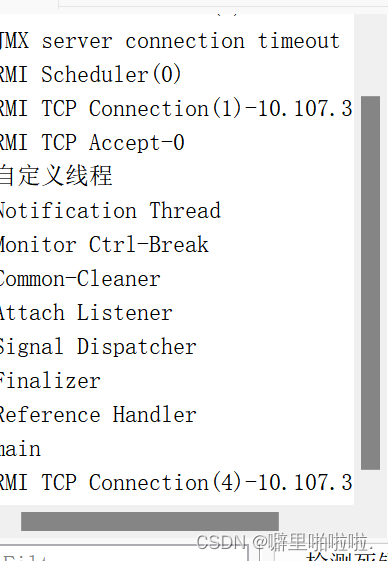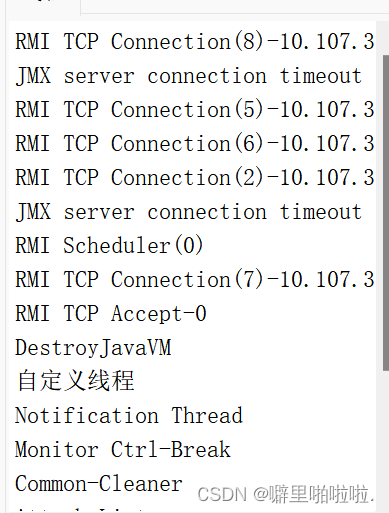首先回顾一下创建线程的几种写法:
1.直接通过继承Thread来实现多线程.
class MyThread extends Thread{
public void run(){
while(true){
System.out.println("hello,Thread");
try {
Thread.sleep(1000);//就是让线程主动进入"阻塞状态",主动放弃去CPU上执行.时间到了
//之后,线程才会解除阻塞状态,重新被调度到CPU上执行.
} catch (InterruptedException e) {
throw new RuntimeException(e);
}
}
}
}
public class Demo1{
public static void main(String[] args){
Thread t=new MyThread();
t.start();
while(true){
System.out.println("hello,main");
try {
Thread.sleep(1000);
} catch (InterruptedException e) {
throw new RuntimeException(e);
}
}
}
}2.通过实现Runnable接口,重写run,把Runnable实例传入到Thread中.
class MyRunnable implements Runnable{
public void run(){
while(true){
System.out.println("hello,Thread");
try {
Thread.sleep(1000);
} catch (InterruptedException e) {
throw new RuntimeException(e);
}
}
}
}
public class Demo2 {
public static void main(String[] args){
Thread T=new Thread(new MyRunnable());
T.start();
while(true){
System.out.println("hello,main");
try {
Thread.sleep(1000);
} catch (InterruptedException e) {
throw new RuntimeException(e);
}
}
}
}3.针对1进行变形,使用匿名内部类继承Thread并重写run方法.
public class Demo3 {
public static void main(String[] args){
Thread t=new Thread(){
public void run(){
while(true){
System.out.println("hello,Thread");
try {
Thread.sleep(1000);
} catch (InterruptedException e) {
throw new RuntimeException(e);
}
}
}
};
t.start();
while(true){
System.out.println("hello,main");
try {
Thread.sleep(1000);
} catch (InterruptedException e) {
throw new RuntimeException(e);
}
}
}
}4.还是匿名内部类,这一次是针对Runnable
public class Demo4 {
public static void main(String[] args){
Thread T=new Thread(new Runnable(){
public void run(){
while(true){
System.out.println("hello,Thread");
try {
Thread.sleep(1000);//休眠,就是让线程主动进入"阻塞状态",主动放弃进入CPU上去执行.
//时间到了之后,线程才会解除阻塞状态,重新被调度到CPU上去执行.
} catch (InterruptedException e) {
throw new RuntimeException(e);
}
}
}
});
T.start();
while(true){
System.out.println("hello,main");
try {
Thread.sleep(1000);
} catch (InterruptedException e) {
throw new RuntimeException(e);
}
}
}
}5.也是最常用的方法,使用lambda表达式,lambda本质上就是针对匿名内部类的平替.
public class Demo5{
public static void main(String[] args){
Thread t=new Thread(()->{
//lambda相当于平替了run,匿名内部类
while(true){
System.out.println("hello,Thread");
try {
Thread.sleep(1000);
} catch (InterruptedException e) {
throw new RuntimeException(e);
}
}
});
t.start();
while(true){
System.out.println("hello,main");
try {
Thread.sleep(1000);
} catch (InterruptedException e) {
throw new RuntimeException(e);
}
}
}
}上述这五种写法本质上都是,1.要把线程执行的任务内容列出来 2.通过Thread的start来创建/启动系统中的线程.Thread对象和操作系统内核中的线程是一一对应的.
接下来介绍Thread这个类的一些方法和属性.
1.Thread() 说明:创建线程对象. 2.Thread(Runnable xxx) 说明:使用Runnable对象创建线程对象
3.Thread(String name) 说明: 创建线程对象,并给线程对象命名.
4.Thread(Runnable xxx,String name) 说明:使用Runnable对象创建线程,并对线程进行命名.
1,2已经介绍过了,这里介绍一下3.4 代码如下:
public class Demo6 {
public static void main(String[] args){
Thread t=new Thread("自定义线程"){
public void run(){
while(true){
System.out.println("hello,Thread");
try {
Thread.sleep(1000);
} catch (InterruptedException e) {
throw new RuntimeException(e);
}
}
}
};
t.start();
while(true){
System.out.println("hello,main");
try {
Thread.sleep(1000);
} catch (InterruptedException e) {
throw new RuntimeException(e);
}
}
}
}
public class Demo7 {
public static void main(String[] args){
Thread t=new Thread(new Runnable(){
public void run(){
while(true){
System.out.println("hello,Thread");
try {
Thread.sleep(1000);
} catch (InterruptedException e) {
throw new RuntimeException(e);
}
}
}
},"自定义线程");
t.start();
}
}
通过下面可以看到成功给创建的进程命名了


第二个代码并没有看到main线程,原因是main线程执行的太快了,已经执行完毕.main线程执行完毕之后就会销毁.
Thread类的属性
ID :注意这里的ID是和PCB上的ID不同,是JVM自己的.获取方法是 getId()
public class Demo8 {
public static void main(String[] args){
Thread t=new Thread(()->{
while(true){
System.out.println("一个线程");
try {
Thread.sleep(1000);
} catch (InterruptedException e) {
throw new RuntimeException(e);
}
}
});
t.start();
System.out.println(t.getId());
}
}
可以看到这个线程的ID是24.
名称:获取方法是 getName()
public class Demo8 {
public static void main(String[] args){
Thread t=new Thread(()->{
while(true){
System.out.println("一个线程");
try {
Thread.sleep(1000);
} catch (InterruptedException e) {
throw new RuntimeException(e);
}
}
});
t.start();
System.out.println(t.getId());
System.out.println(t.getName());
}
} 
状态:获取方法 getState()
public class Demo8 {
public static void main(String[] args){
Thread t=new Thread(()->{
while(true){
System.out.println("一个线程");
try {
Thread.sleep(1000);
} catch (InterruptedException e) {
throw new RuntimeException(e);
}
}
});
System.out.println(t.getId());
System.out.println(t.getName());
System.out.println(t.getState());
}
}可以看到上述代码的状态是NEW

优先级:获取方法 getPriority()
public class Demo8 {
public static void main(String[] args){
Thread t=new Thread(()->{
while(true){
System.out.println("一个线程");
try {
Thread.sleep(1000);
} catch (InterruptedException e) {
throw new RuntimeException(e);
}
}
});
System.out.println(t.getId());
System.out.println(t.getName());
System.out.println(t.getState());
System.out.println(t.getPriority());
}
} 是否后台线程:获取方法 isDaemon() 还是刚才的代码,执行这个获取方法 isDaemin()得到的结果如下:
是否后台线程:获取方法 isDaemon() 还是刚才的代码,执行这个获取方法 isDaemin()得到的结果如下:
 表示创建的这个线程不是后台线程,这里介绍一下这个名词.
表示创建的这个线程不是后台线程,这里介绍一下这个名词.
后台线程:这样的线程即使还在继续执行,也不能阻止java进程结束.
前台线程:这样的线程如果还没有执行完的话,此时java进程是一定不会结束的.
在java代码中,main线程就是前台线程.另外程序员创造出来的线程,默认情况下都是前台线程.可以通过setDaemon()的方法把线程设置为后台线程.
如下,t默认是前台线程,当main线程执行完后,进程不会结束,t线程还在执行会继续打印.但是当把t线程设置为后台线程的时候,当main线程执行完后,进程会立即结束,停止打印.
public class Demo8 {
public static void main(String[] args) {
Thread t = new Thread(() -> {
while (true) {
System.out.println("一个线程");
try {
Thread.sleep(1000);
} catch (InterruptedException e) {
throw new RuntimeException(e);
}
}
});
t.setDaemon(true);
t.start();
}
} 可以看到由于main线程执行完之后,进程就结束了,此时t线程还没有打印.这里要注意的是t.setDaemon()一定要在t.start()的前面. 但也有打印一次的情况.如下:
可以看到由于main线程执行完之后,进程就结束了,此时t线程还没有打印.这里要注意的是t.setDaemon()一定要在t.start()的前面. 但也有打印一次的情况.如下:
 出现的原因主要是,线程之间是抢占式执行的,调度顺序不确定.
出现的原因主要是,线程之间是抢占式执行的,调度顺序不确定.
是否存活:指的是系统中的线程(PCB)是否存在. Thread对象的生命周期和PCB的生命周期是不一样的.比如:
public class Demo9 {
public static void main(String[] args) throws InterruptedException {
Thread t=new Thread(()->{
});
//这里已经创建了Thread的实例,Thread对象已经诞生了.但是内核中的PCB还内有诞生.
t.start();
//通过t.start()才创建出线程.(PCB才真正创建出来并被加入到链表中.)
Thread.sleep(100000);
//由于t线程中的啥都没写,t线程的执行瞬间结束,内核中的线程和PCB被销毁.
//但是在sleep结束之前,t指向的Thread对象还是存在的.此时,就看到,系统中的线程先结束了,但是t仍然存在.
System.out.println(t.isAlive());
}
}
中断一个线程:
1.纯自己来实现,控制线程结束
public class Demo10 {
public static boolean isRunning=true;
public static void main(String[] args){
Thread t=new Thread(()->{
while(isRunning){
System.out.println("hello,Thread");
}
System.out.println("该线程结束执行");
});
t.start();
System.out.println("结束执行创建的线程");
isRunning=false;
}
}
2.使用Thread提供的interrupt方法和isInterruptted方法,来实现上述的效果.
public class Demo11 {
public static void main(String[] args){
Thread t=new Thread(()->{
while(!Thread.currentThread().isInterrupted()){
System.out.println("hello,Thread");
try {
Thread.sleep(1000);
} catch (InterruptedException e) {
break;
}
}
//Thread.currentThread是个静态方法,能够获取到当前线程即t引用.
//isInterrupted 线程内置的标志位 boolean变量. true表示线程要终止了,false表示线程要继续执行.
});
t.start();
try {
Thread.sleep(3000);
} catch (InterruptedException e) {
throw new RuntimeException(e);
}
t.interrupt();
}
}





















 6131
6131

 被折叠的 条评论
为什么被折叠?
被折叠的 条评论
为什么被折叠?








